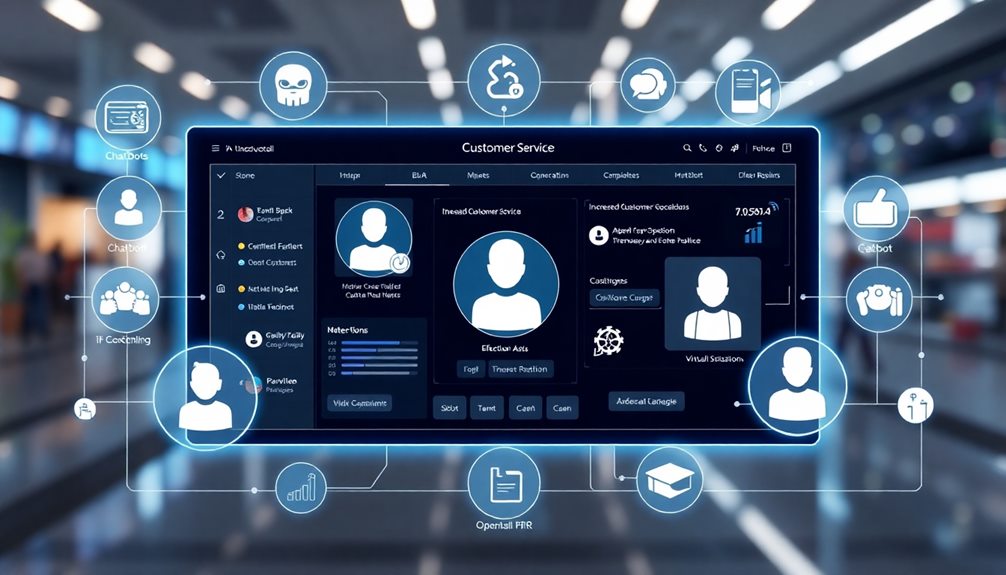Automated customer service systems are game-changers for your online business. They streamline processes, reduce manual workloads, and guarantee 24/7 support. With AI chatbots handling common inquiries instantly, your team can focus on complex issues. This leads to lower operational costs and happier customers—nearly 89% are more likely to repurchase after a positive experience. Key tools include chatbots and self-service portals, which empower customers to find answers themselves. However, it's essential to maintain a human touch. Curious about how to effectively implement these systems or the latest trends? Keep going to uncover more insights.
Key Takeaways
- Automated customer service systems, like AI chatbots, provide 24/7 support, improving response times and customer satisfaction.
- These systems streamline processes, reducing operational costs while enhancing agent productivity by managing routine inquiries.
- Implementing automation requires identifying repetitive tasks and selecting suitable tools for effective integration into existing workflows.
- Continuous feedback and performance metrics help refine automated solutions, ensuring they meet evolving customer needs and preferences.
- Future trends indicate increased automation, with over 70% of inquiries expected to be handled through automated channels by 2024.
Understanding Customer Service Automation

Understanding customer service automation is vital in today's fast-paced digital world. By employing customer service automation tools, you can streamline processes and enhance efficiency.
For instance, automated systems like AI chatbots can handle customer inquiries instantly, allowing you to focus on more complex tasks. These systems utilize machine learning and natural language processing to route inquiries effectively and simplify interactions. Additionally, implementing a holistic SEO approach can boost the visibility of your customer service automation solutions, ensuring that they reach the right audience.
Automating repetitive tasks helps reduce the burden on your customer support team, ensuring they're available for more important issues. Interactive voice response systems guide callers through basic inquiries, providing immediate assistance and improving response times. This 24/7 availability not only maintains consistent communication channels but also contributes to an enhanced customer experience.
Moreover, implementing customer service automation can appreciably lower operational costs. With 89% of consumers likely to repurchase after a positive service experience, improving customer satisfaction becomes vital.
Benefits of Automation for Businesses

As businesses endeavor to meet growing customer expectations, the benefits of automation become increasingly clear. Automated customer service systems provide 24/7 support, ensuring you meet the demand for quick responses. Given that 77% of consumers find it challenging to reach an agent, this capability is essential.
By implementing customer support automation, you can greatly reduce operational costs as AI tools handle routine inquiries, allowing your team to focus on more complex issues. Additionally, digital entrepreneurship offers low startup costs that can be leveraged by businesses to enhance their automated systems.
Moreover, automating routine tasks not only saves you money but also enhances agent productivity. With the ability to manage multiple customer interactions simultaneously, your team can tackle more inquiries without increasing headcount. This efficiency leads to improved customer satisfaction; in fact, 89% of consumers are likely to repurchase after a positive service experience, driven by the swift resolutions automated systems provide.
Additionally, utilizing automated reporting and analytics helps you gather valuable customer feedback, refining your strategies over time.
Ultimately, embracing these automation benefits positions your business for growth while ensuring your customers receive the high-quality service they expect.
Key Tools for Customer Service Automation

When it comes to automating customer service, several key tools can transform your operations and elevate the customer experience. Chatbots are essential customer service automation tools, handling inquiries and providing instant responses. While 86% of consumers prefer real interactions, chatbots excel at managing simple queries efficiently.
Additionally, incorporating AI-powered tools can greatly enhance chatbot effectiveness by enabling them to learn from past interactions and improve over time, as AI systems utilize algorithms to process data and make decisions Deloitte's AI Expertise.
Interactive Voice Response (IVR) systems enhance customer experience by directing calls and delivering basic information through pre-recorded messages, ensuring timely support.
In addition, help desk and ticketing systems like Zendesk and Freshdesk streamline your processes by managing customer support tickets, automating ticket creation, and offering analytics for continuous improvement.
AI-powered tools leverage machine learning and natural language processing to analyze customer interactions, classify inquiries, and effectively route them. This greatly improves response times and elevates customer satisfaction.
Lastly, self-service portals empower customers to find answers independently, drastically reducing incoming support requests and enhancing service efficiency.
Strategies for Effective Implementation

To effectively implement automation in customer service, you first need to identify where it can streamline processes.
Next, choose tools that fit your specific needs and guarantee they integrate smoothly with what you already have.
Identify Automation Opportunities
Identifying automation opportunities is crucial for enhancing your customer service efficiency. Start by evaluating your existing customer support processes to pinpoint areas with high inquiry volumes. Focus on repetitive and simple tasks that can be automated, as these often yield the best efficiency gains. By automating routine tasks, you free up your team to handle more complex customer inquiries, ultimately improving overall customer experience.
Next, select automation tools that align with your business needs and customer expectations. Make certain they integrate seamlessly with your current workflows. Implement automation gradually—begin with basic tasks to minimize confusion. This approach allows for effective monitoring of performance metrics, such as average resolution time and customer satisfaction scores.
Don't forget to train your staff on the new automation systems. Emphasize the importance of maintaining a human touch in customer interactions, as this will help avoid frustration among customers.
Choose Suitable Tools
Choosing the right automation tools is vital for streamlining your customer service operations and meeting your specific needs. Start by evaluating your existing customer support processes to pinpoint high-volume and repetitive tasks ripe for automating customer service.
Look for customer service automation software that aligns with your objectives and customer expectations, ensuring these automated tools can integrate seamlessly with your current workflows.
When you implement customer service automation, consider a gradual rollout. This allows you to monitor effectiveness and make adjustments based on performance metrics like resolution times and customer satisfaction scores.
Training your team on the selected automation systems is essential, as this helps maintain a human touch in interactions and prevents redundancy in communication.
Don't forget to continuously gather customer feedback and analyze data to refine your automated solutions. This ongoing process not only enhances the overall customer experience but also boosts service effectiveness.
Monitor Performance Metrics
Monitoring performance metrics is essential for understanding how automation affects customer experience. You should focus on key indicators like average resolution time and customer satisfaction scores. Regular audits of your automated systems can help you identify areas for improvement, allowing the technology to adapt to changing customer needs and business goals.
Utilizing performance analytics reveals patterns in customer inquiries, guiding you to adjust automated responses for enhanced efficiency. Establishing clear success benchmarks enables you to measure the effectiveness of your automated customer service systems. This clarity allows for data-driven decisions that can markedly impact your service quality.
Incorporating automated reporting tools streamlines the collection and analysis of performance metrics, giving you valuable insights into your operations. These insights will help you drive continuous improvement in customer service delivery, ensuring that your automated systems meet and exceed customer expectations.
Challenges in Automating Customer Support

Automating customer support presents several significant challenges that can impact your business's reputation and customer satisfaction. While automation can streamline customer service operations, it often falls short in addressing complex customer issues. You risk frustrating customers who prefer human interaction, especially when 86% of them want to talk to real people.
Consider these emotional challenges you might face:
- Frustration: 77% of consumers struggle to reach a live agent when needed.
- Trust issues: Lack of accessibility can lead to diminished trust in your automated system.
- Unresolved queries: Complex issues often remain unresolved by automated responses.
- Negative impacts: Poor management can affect customer satisfaction and retention rates.
- Customer experience: A lack of personal touch can diminish the overall experience.
To navigate these challenges effectively, guarantee clear pathways for customers to reach human representatives.
Regular monitoring and management of automated interactions are vital for preventing potential negative impacts on customer satisfaction.
Future Trends in Customer Service Automation

Embracing advanced technologies is set to transform customer service automation in the coming years. By 2024, over 70% of customer service inquiries will be managed through automated channels, markedly boosting customer satisfaction and cutting operational costs by up to 30%.
AI technologies, particularly generative AI and natural language processing, will enhance automation systems, enabling more human-like interactions and effective complex issue resolution by 2025.
The rise of omnichannel support will allow you to provide seamless customer experiences across various platforms. With automation playing a vital role, your messaging will remain consistent, guaranteeing quick resolutions, no matter where your customers reach out.
As privacy regulations tighten, it's important to implement robust data protection measures within your automation systems. This guarantees compliance while still delivering personalized customer experiences through intelligent data analysis.
In this evolving landscape, you'll find that investing in automated customer service not only improves efficiency but also fosters loyalty, as you meet the diverse needs of your customers.
Frequently Asked Questions
What Is an Automated System for Customer Service?
An automated system for customer service uses software to manage inquiries, providing quick responses without human input. It streamlines the process, allowing you to get assistance anytime, improving efficiency and saving businesses time and money.
How to Automate Customer Service?
Did you know that 70% of customers prefer self-service options? To automate customer service, identify repetitive tasks, choose suitable tools, and implement clear workflows. Train your team to balance automation with personal assistance for better experiences.
What Is an Example of Automated Customer Service?
An example of automated customer service could be a chatbot on a website. It answers your questions instantly, guiding you through options and providing assistance without waiting for a human representative, enhancing your experience.
What Is an Automated Online Business?
Running an automated online business is like sailing smoothly on calm waters; you use technology to streamline tasks, allowing for round-the-clock operations and efficient handling of customer interactions, making your life easier and more productive.
Conclusion
In a world where robots might just be your next customer service rep, can you imagine a chatbot declaring, "I understand your feelings, but my circuits are fried!"? Embracing automation is like inviting a well-intentioned but awkward relative to dinner; it's got potential, but things might get weird. So, as you plunge into this brave new world of automated support, remember: while bots may offer efficiency, they sure can't replace that good old-fashioned human touch—or a good laugh!









